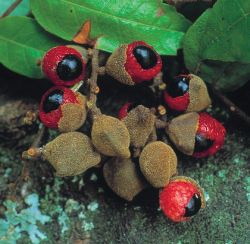Plant
Doctor Archive
Propagating
natives from seed
  I
AM a retired sheep and cattle farmer who now wants to propagate
natives so I can fill in any empty space I can find. I have helped
vegetate the cliffs of Kairahau Beach to the tune of some 300 potted
lancewoods, kowhai, cabbage trees and coprosmas for birds. Have
you any hints for propagation of titoki and puriri from seed? I
AM a retired sheep and cattle farmer who now wants to propagate
natives so I can fill in any empty space I can find. I have helped
vegetate the cliffs of Kairahau Beach to the tune of some 300 potted
lancewoods, kowhai, cabbage trees and coprosmas for birds. Have
you any hints for propagation of titoki and puriri from seed?
 GROWING
titoki (Alectryon excelsus) from seed is quite straightforward.
You need to collect the seed when it's fully ripe, which is normally
mid to late summer, depending on the season. When the seed is ripe,
the capsules on the trees start to split, exposing the shiny black
seed with its bright red fleshy aril attached. When the first few
seeds are visible you can collect all the capsules and open them
by hand to remove the seeds. Clean off as much of the red flesh
as practicable (it's usually quite easy to pick off by hand) and
sow the seeds straight away in a free-draining seed-raising mix.
They'll probably take a couple of months to germinate, depending
on your conditions. If cold, they may not do much until spring. GROWING
titoki (Alectryon excelsus) from seed is quite straightforward.
You need to collect the seed when it's fully ripe, which is normally
mid to late summer, depending on the season. When the seed is ripe,
the capsules on the trees start to split, exposing the shiny black
seed with its bright red fleshy aril attached. When the first few
seeds are visible you can collect all the capsules and open them
by hand to remove the seeds. Clean off as much of the red flesh
as practicable (it's usually quite easy to pick off by hand) and
sow the seeds straight away in a free-draining seed-raising mix.
They'll probably take a couple of months to germinate, depending
on your conditions. If cold, they may not do much until spring.
With puriri (Vitex
lucens) you can sometimes find some ripe (red) berries hanging
on trees at any time of year, but usually there's a good crop late
summer to early winter. The best way to clean them is soak in water
for a few days until the flesh goes mushy. Then mash them up and
remove the quite large, blackish seeds.
There are a couple of
schools of thought as to what you should do next. Some people say
stratifying the seeds encourages more even germination, as puriri
seeds can be erratic. Others recommend you sow them straight away
and leave in a cool place over winter. Then simply remove seedlings
for potting up as they appear the following season, leaving the
remaining seeds to germinate when they will.
Stratifying involves
mixing the seeds in moist sand and placing the mixture in a sealed
container or plastic bag in the fridge for six to eight weeks before
sowing. You need to make sure the seeds remain moist while in the
fridge. After stratifying, sow them and place in a sheltered spot.
Avoid extremely high temperatures - don't put them in a poorly ventilated
greenhouse and don't let them dry out.
You may be interested
to know you can also propagate puriri from leafy cuttings taken
any time from mid to late summer. Ideally though, for revegetation
purposes, you should raise them from seed to allow for as much genetic
variation as possible, and where practicable collect the seeds from
a range of different trees close to the area you intend to plant.
Weekend
Gardener, Issue 151, 2004, Page 27
Reproduced with permission from the former Weekend Gardener magazine. The views expressed here are not necessarily those of the RNZIH.
|
 |
 |
|